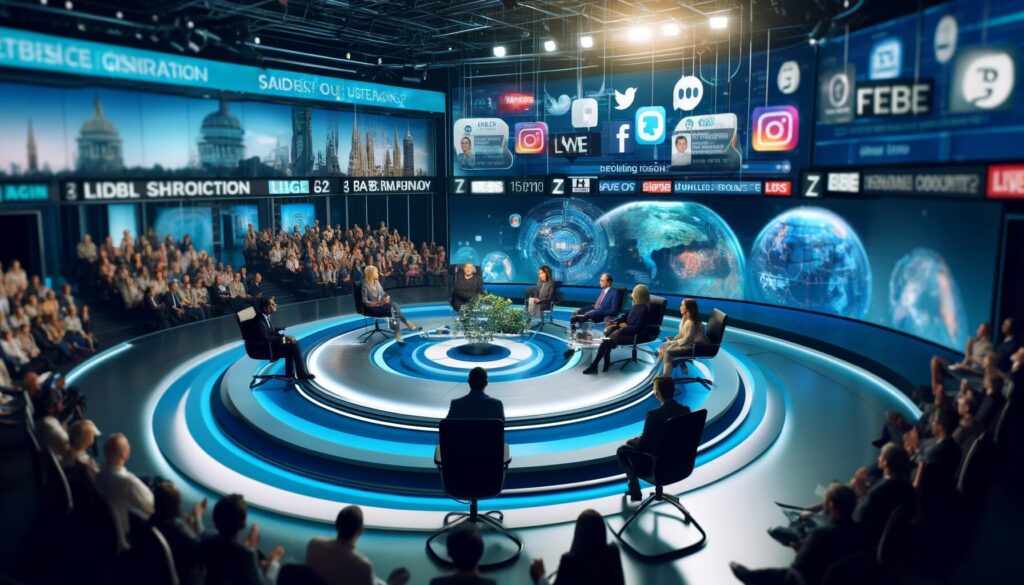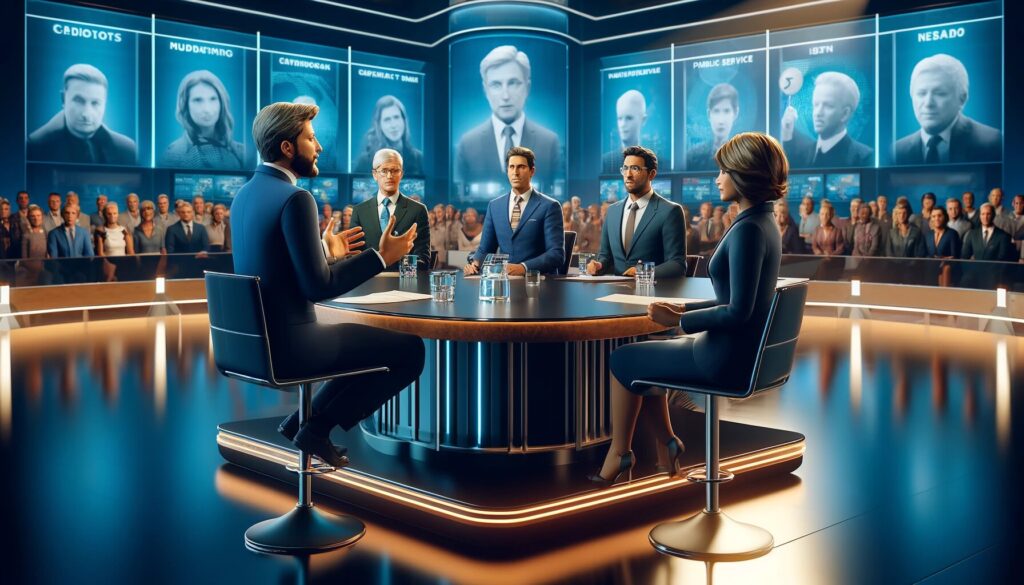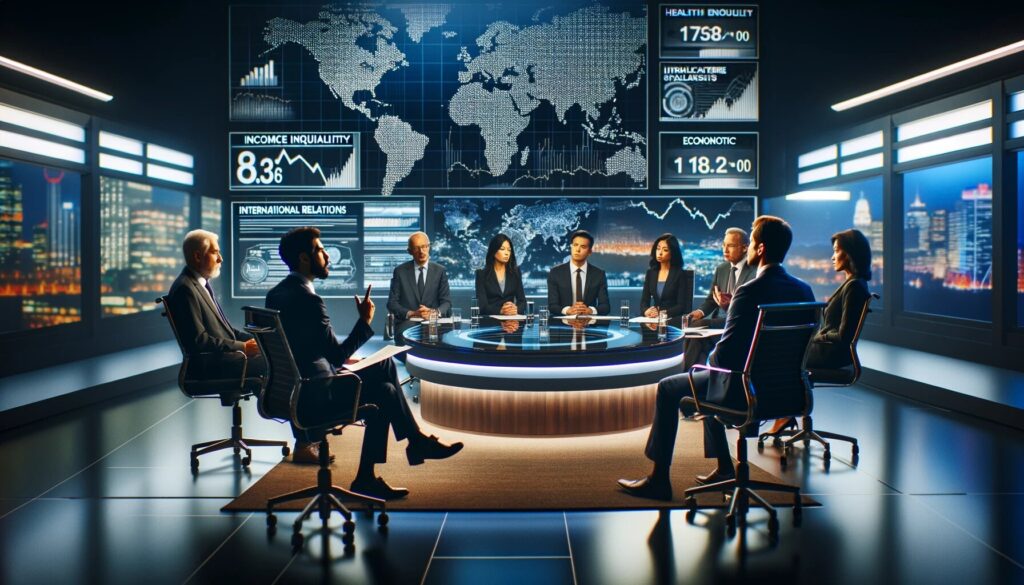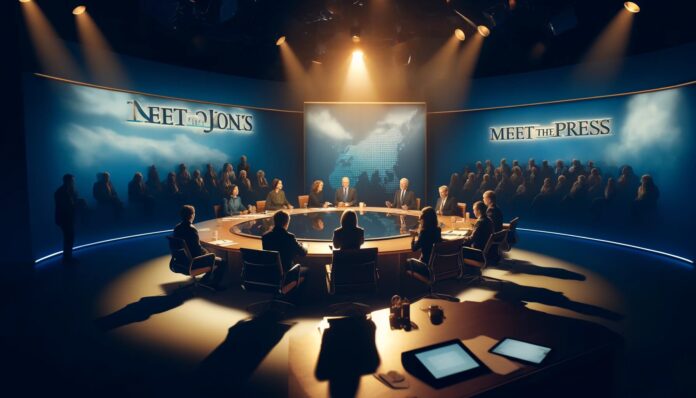“Meet the Press,” which is the trusted voice of American television, stands at the top of the political spectrum that shapes the policy and political establishments forward. In the 76th season, episode forty-nine (Meet the Press S76E49) presented a great deal of investigation into what is happening now from the political, social, and global scenes.
Through the youngest-running talk show in the spectrum of television,” Meet the Press,” not only are the current times delved into but also function in the role of a mirror, wherein the shifts in policy and public opinion can be seen over time.
Here, the television show focused on the current election campaign, key economic issues facing the country, and diplomatic aspects of the state relationship, and, so, in a few steps, the director successfully characterized the entire decade in this way.
The importance of the phenomenon rather lies beyond discussion. The main role that it plays is to develop into a barometer, which calibrates the influence and is thereby a basis for the diversity and complexity of the broad U.S. society and the wider international community.
Key Themes Explored
During season S76E49 of “Meet the Press,” some critical concepts related to modern geopolitics and social settings were unmasked. The discussion commenced with an in-depth analysis of the forthcoming election, which, in turn, brought political turmoil against public dismay into clear view.
From there, the discourse turned to economic challenges that the panelists had to tackle, including closing income gaps and the problem of stagnant social mobility. Each topic is sold in a detailed manner to unearth the root causes and likely resolutions and to provide viewers with a full appreciation of the gravity of each issue as well as its impact.
As I observed the presentation on international relations, I couldn’t suppress the amazing feeling of being in awe of what was happening out there. It became obvious how complicated the web of diplomacy, trade, and conflict that, in the 21st century, shapes what we call inter-state relations. This section, in particular, has made all of it very deep thinking as it relates to diplomatic interactions nowadays and their long-term effects on international peace.
By engagement in such debates, “Meet the Press” gave a broad picture of the crucial matters to which policymakers should pay particular attention and which should prompt those concerned to elaborate holistic strategies of governance and cooperation on the international scene.
U.S. Legislative Dynamics and Partisanship
This section will delve deeply into the recent political maneuvers within the United States, highlighted in episode S76E49. The episode’s focus on legislative developments provided a critical overview of the tactical shifts in dialogue styles among American lawmakers.
The speakers pinpointed the direct implication in real life that the division is a reflection of more than the broader societal divisions. The possibility of cohesion in the future is threatened by the increasing polarization trend that is challenging the democratic discourse.
The analysis would also include evaluating how the legislative developments impact policymaking and governance and identifying factors that impede reaching bipartisanship during the period marked by growing hostility and distrust in political camps.
By emphasizing the legislative aspects of policymaking that occurred in the divided national context as well as their implications, this part of the discussion will showcase the complexities of policymaking at the national level and the potential avenues to decrease division and adopt progressive governance.

Socioeconomic Challenges
In an episode of “Meet the Press” S76E49, the socioeconomic issues were decisively prioritized as the critical issues underlying the reform of healthcare, fundamental income inequality, and social mobility.
The Evident conversation on healthcare legislation was also notable, shedding light on the imbalances that result in unequal access and quality of healthcare in the U.S. Speakers addressed the need for a transformation policy while noting that the current approach may need to be more equitable in providing health services for all citizens.
In this discussion, the problem of income inequality was analyzed as the gap between rich and poor is getting wider due to the gap between rich and poor, which shows the fact that social justice principles of fairness and opportunity are not followed in American society.
Social mobility, or actually how inadequate it is, was a constant theme here, with experts defining all obstacles that do not permit the people from the bottom of the social stratum to go up: education quality, job availability, and systemic biases.
The next part would analyze these matters in detail, supporting the facts with data and the views of experts to demonstrate the intricate nature of the scenarios and the need for general policies that go to the root of the matter and solve the basis of social and economic inequalities.
Diplomacy and Global Crises Insights
The discussion of international affairs in episode S76E49 of “Meet the Press” offered an intricate overview of the current global landscape, where diplomatic strategies and crises intersect with the interests of national and international stability. From diplomatic talks with major countries to humanitarian emergencies and international tensions, the episode highlighted many key areas of concern for the existing system of the U.N.
The panelists covered different areas pertaining to the management of the major societal issues from the views of the world stage, observing the effects of the existing strategies and the need for adaptive strategies in light of the differences encountered during the shifting of global dynamics.
This section will pursue the highlighted topic to offer a different perspective on how various countries and international organizations approach dealing with the webbing relationships that have become more and more a norm in the modern world.
The goal is to impart a profound essence of world affairs in the hands of everyone and demonstrate the importance of a positive and knowledgeable strategy in foreign policy.
Diverse Perspectives from Experts Across Fields
The ideal selection of the panel participants in “Meet the Press” S76E49 was most critical to the enrichment of the discussion panel, which brought a variety of viewpoints, experiences, and expert analyses.
The session was graced by highly cerebral individuals ranging from academics to media professionals, public servants, and activists. As a result, the multi-colored carpet of backgrounds and experiences was all seen and heard.
That diversity in panelists was one of the major factors that made it possible to dive deeper into the core areas since each panelist represented their particular expertise field of the theme under discussion. Within this, an overview of the background of the panelists, their contributions to the debate, and their diverse views is provided; this brought out difficult topics in completely new ways.
Having the panelists focus on the dynamic exchanges of ideas and concepts will elaborate on the importance of the varieties of opinions and viewpoints in public discourse.
In this manner, it will be illustrated during the review of this aspect of the article that people from different backgrounds who have diverse views, findings, and interpretations can help widen and make public discussions more comprehensive and effective.

Backgrounds and Expertise
“Meet the Press” S76E49 not only provided a space for discussing all crucial matters, but also had a panel of the highest standing whose specializations were literature, diplomacy, and history, to mention but a few, making the discussion more profound.
Every panel member was carefully selected to cover different topics of the episode’s thematic issues, including political science professors, economic analysts, veteran diplomats, international-level civil servants, and grassroots personnel alike.
The article will also talk about the professional and personal life of these panelists, exploring where their experience and expertise come from and making the interaction as insightful as possible.
The scenario will be unveiled by disclosing the points where the panelist’s backgrounds benefited them by offering a rare perspective to the general perception or standing up for what is right, thereby improving the quality of the debation.
With the personal stories and professional track records studied, this segment would stress the need for a convenient team that brings all the necessary information that will help in an informed and profound conversation.
Insights from the Discussion
A multitude of different opinions and insights were experienced during the “Meet the Press” S76E49 talk show. Every panelist presented their take stemming from the given field of expertise, with a deepening of the discussion and the introduction of new viewpoints.
This part of the article will discuss these contributions and provide detailed insights. By critically looking at how each one adds value, it brings more to what was initially understood.
First, a political analyst can pinpoint the impact of the last legislative bill by presenting the state of social inequality. At the same time, an international relations expert can illustrate the intricacies of a new diplomatic initiative.
This section of the report will not only provide an analysis of this but also look at the consequences that these moments brought, considering the large picture of democracy, equity, and global cooperation.
Thus, in this part of the episode, attempts are made to intertwine these individual experiences, which together make a whole of the program production and provide a full view of the show’s intellectual background that is full of dynamic idea interchange, which is the main feature of “Meet the Press.”
Diversity and Depth of Discussion
The eclectic make-up of the panel in “Meet the Press” S76E49 implied that there wasn’t a single opinion controlling the conversation, eliminating the possibility of a singular view. That allowed for a deeply insightful and intricate discussion.
This section compares and contrasts the ideas and thoughts of the panelists to the point of thoroughness in concerning these issues. It would discover these issues being depicted by different characters with distinctive points of view in the inclusive scene of an economy, health care, international diplomacy, the complicated matrix of interdependencies, and contradictions being brought to the spotlight.
Apart from that, the assessment involves determining the level of the discussion, the factor that prompts better and more meaningful debates based on the different backgrounds and experiences of the panelists. An evaluation of this diversity question would improve its efficiency in showing paradoxical wisdom and increasing knowledge among the audience.
The emphasis here is on the argument that various points of view should be present in media negotiations, especially in connection with serious problems and contradictory topics.
Moderation Style and Impact on Dialogue
The role of the host in “Meet the Press” S76E49 was crucial in steering the conversation, ensuring that it remained focused yet fluid. The analyzed part will address the host’s moderation manners that illustrate the critical case-based decision techniques used to keep the discussion live among the panelists and involve the audience.
It would compare how the guest acted in this particular show with the importance of maintaining the dynamic dialogue, which was in-depth but realistic, given the constraints of the format. Furthermore, during the panel section, the host will give questions that push the panelists to think more deeply about the topics and provide them with space to answer in a nuanced way.
Sustaining and underscoring the role of a host in the general flow of discourse would be another point to tackle, proving this kind of moderation might be the one which can increase the level of the talk and, therefore, let the people participate and expose their points of view sufficiently. This part of the lecture will build the importance of hosts and the connection being part of the discussion.
Questions and Their Impact on Discussion
The conversational aspect of the panel upon “Meet the Press” S76E40 was highly dependent on the type, number, and origin of the questions asked by the moderator and by those sent in by the viewers.
This section will analyze how these questions influenced the depth and direction of the discussions. It would highlight specific instances where audience questions prompted panelists to address particular concerns, sometimes leading to revelations or unexpected admissions that enriched the overall discourse.
The effectiveness of follow-up inquiries by the host, designed to delve deeper into the panelists’ responses, would also be examined. This detailed analysis aims to illustrate the critical role that well-considered questions play in engaging both the panelists and the audience, fostering a dynamic and interactive environment that enhances the educational value of the program.
Social Media Interactions
In the digital age, the interaction between television programming and social media is pivotal, and “Meet the Press” S76E49 was no exception. This section of the article will explore the audience’s reaction to the episode as it unfolded on various social media platforms.
By examining tweets, comments, and shares, this part would assess how viewers engaged with the content of the episode, highlighting significant trends in viewer responses and sentiment.
The analysis would include how specific moments or discussions within the episode triggered broader conversations online and how these online discussions reflected or diverged from the opinions expressed by the panelists.
This examination aims to showcase the impact of the program beyond its broadcast, illustrating how it catalyzes dialogue and debate across multiple platforms.

Influencing Public Discourse and Policy
The influence of “Meet the Press” S76E49 extends beyond its immediate broadcast, affecting public discourse and potentially informing policy decisions. This section will delve into the episode’s role in shaping public opinion and its potential implications for policymaking.
It would examine how the discussions could influence legislative priorities or contribute to a shift in public policy debates, citing instances from past episodes where similar impacts were observed.
Additionally, this part would discuss how the show’s portrayal of certain issues might affect public perceptions and attitudes, potentially leading to civic engagement or advocacy. Via this analysis, the article aims to highlight the substantial and lasting influence that a well-executed episode of “Meet the Press” can have on both public opinion and policy.
Behind the Scenes
Seeing how Meet The Press came into being during S76E49 is vital and improves our knowledge of the intricacies of broadcasting a well-informed and influential newscast. In this part, I will let my audience see an inside view of the production process, which starts with picking the topic, getting ready, and organizing the studio.
In addition to obstacles that occurred in the process of production—like the online adjustment or technical issues at the last minute—we will analyze them in order to show the production team’s flexibility and adaptivity.
This segment seeks to elucidate how it all happens and gives the viewers a new perspective on just how much process and problem-solving is involved in directing an episode, thereby appreciating the level of effort exerted in each program such that the quality and integrity that the show itself enjoys become more apparent.
Critical Review
Every episode of “Meet the Press” offers a chance to reflect on what was achieved and what could be improved. This final section will critically review S76E49, discussing its strengths, such as the depth of analysis and the diversity of perspectives presented.
It would also identify areas where the episode fell short, such as segments that benefited from more time or topics that deserved further exploration.
Suggestions for future episodes could be offered, focusing on how the show could continue to evolve and respond to viewer feedback. This constructive critique is aimed at fostering a continuous improvement mindset, ensuring that “Meet the Press” remains a cornerstone of political journalism.
Assessment of Its Overall Impact and Significance in the Media Landscape
The role of “Meet the Press” S76E49 in the broader media landscape can hardly be overstated. This section will assess the overall impact of the episode, highlighting how it fits into the historical context of the show and its enduring influence on public discourse.
The analysis would explore how the episode contributed to journalistic standards, particularly in terms of depth, rigor, and the balance of discussion.
It also considers the episode’s role in promoting informed civic engagement by providing viewers with a platform that not only presents diverse viewpoints but also encourages critical thinking and public involvement in political processes.
Furthermore, this part would evaluate how “Meet the Press” acts as a check on power by holding public figures accountable and asking tough questions that other segments of the media might shy away from.
Through this comprehensive assessment, the article aims to underline the significance of the program as a pillar of political journalism and a beacon of media integrity.
Discussion on the Lasting Legacy of the Episode
As with any significant piece of journalistic work, “Meet the Press” S76E49 is likely to leave a lasting legacy. This section will discuss the specific parts of the episode that might endure in the collective memory of its audience and continue to influence discussions in the future.
It would consider the episode’s contribution to ongoing debates around the topics it covered—such as legislative reforms, social inequalities, and international diplomacy—and how these discussions might evolve based on the insights provided.
The potential for this episode to be referenced in future scholarly work or media analysis would also be explored, highlighting its role in shaping the narrative around key issues and events.
Additionally, this part would reflect on how this episode stands in comparison to other memorable episodes of “Meet the Press,” identifying what makes it particularly noteworthy or unique in the show’s long and storied history.
Comparisons with Previous Episodes
To contextualize “Meet the Press” S76E49 within the series’ extensive archive, this section would draw comparisons with previous episodes. It would analyze how the themes and discussions have evolved, reflecting shifts in political climates, societal concerns, and global challenges.
By highlighting similarities and differences with past episodes, this part would provide insights into the show’s adaptability and its responsiveness to changing viewer expectations and world events.
The evolution of the show’s format and content over the decades will be examined, showing how “Meet the Press” has managed to remain relevant and influential by continuously refining its approach to address the most pressing issues of the day.

Identification of Recurring Themes and Evolving Narratives
Building on the comparisons with past episodes, this section will identify recurring themes and evolving narratives that have characterized “Meet the Press” over the years. It would delve into how certain issues have remained at the forefront of the program’s agenda, such as political accountability, economic policies, and human rights. In contrast, others have gained prominence only in response to specific historical moments.
This analysis would provide a deeper understanding of the cyclical nature of certain debates and how new developments can reshape old discussions.
The ability of “Meet the Press” to both reflect and influence the national conversation would be emphasized, showcasing its role in continuously engaging with and reinterpreting the most significant challenges facing society.
Conclusion
To conclude, “Meet the Press” S76E49 embodies the essence of what makes the show a cornerstone of American television journalism. Through its comprehensive coverage of critical issues, engaging discussions, and thoughtful presentation, the episode not only informed viewers but also challenged them to think critically about the world around them.
The legacy of this particular episode, as with many before it, lies in its ability to foster informed dialogue and influence public discourse, underscoring the show’s ongoing relevance in a rapidly changing world.
As “Meet the Press” continues to adapt and evolve, it remains a vital resource for viewers seeking to understand the complexities of politics, society, and the global landscape.
Also Read About: Mastering Logistics with Shipn Utsunomiya: A Comprehensive Guide
FAQ’s About Meet the Press S76E49
What were the main topics discussed in Meet the Press S76E49?
The episode covered a range of issues, including political developments in the U.S., socioeconomic challenges, international affairs, and global crises.
Who were the guests on Meet the Press S76E49?
The episode featured a diverse panel of experts from various fields, such as politics, economics, healthcare, and international relations.
What specific socioeconomic issues were highlighted in the episode?
Key socioeconomic issues discussed included healthcare reform, income inequality, and barriers to social mobility.
How did the episode address international affairs?
The discussion focused on foreign policy, diplomatic interactions with allies and adversaries, and the handling of global humanitarian crises.
What was the consensus about the political climate in the United States, as discussed in the episode?
The episode delved into the growing partisan divisions, the challenges in policymaking, and the prospects for bipartisanship in a politically charged environment.
Were there any solutions proposed for the challenges discussed?
While specific solutions were not always detailed, the discussion aimed to highlight effective policies and suggest broader approaches for addressing the issues.
How did the panelists’ backgrounds influence the discussion?
Each panelist’s unique background brought different perspectives to the discussion, enriching the conversation with varied insights on each topic.
What role did the host play in the episode?
The host moderated the discussion, guided it to ensure a comprehensive analysis of the topics, and challenged the panelists with probing questions.
How did the audience engage with the episode?
Audience engagement was facilitated through social media, where viewers could comment and interact in real-time, reflect on the discussion, and share their views.
What impact did the episode aim to have on public discourse and policy?
The episode sought to inform and influence public discourse by providing a platform for thoughtful discussion on pressing issues, potentially shaping opinions, and encouraging civic engagement in policymaking processes.



